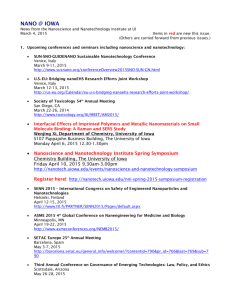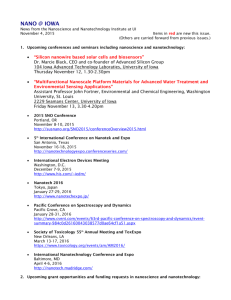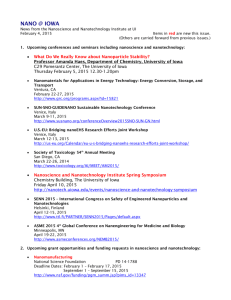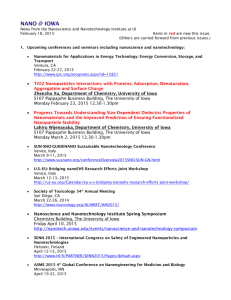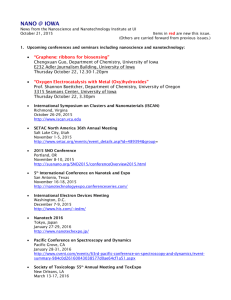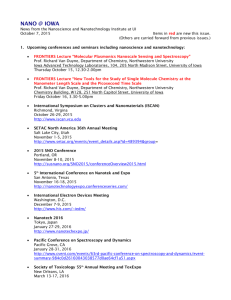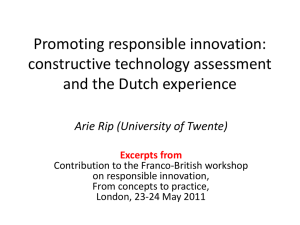November 19, 2015 - Nanoscience and Nanotechnology Institute
advertisement
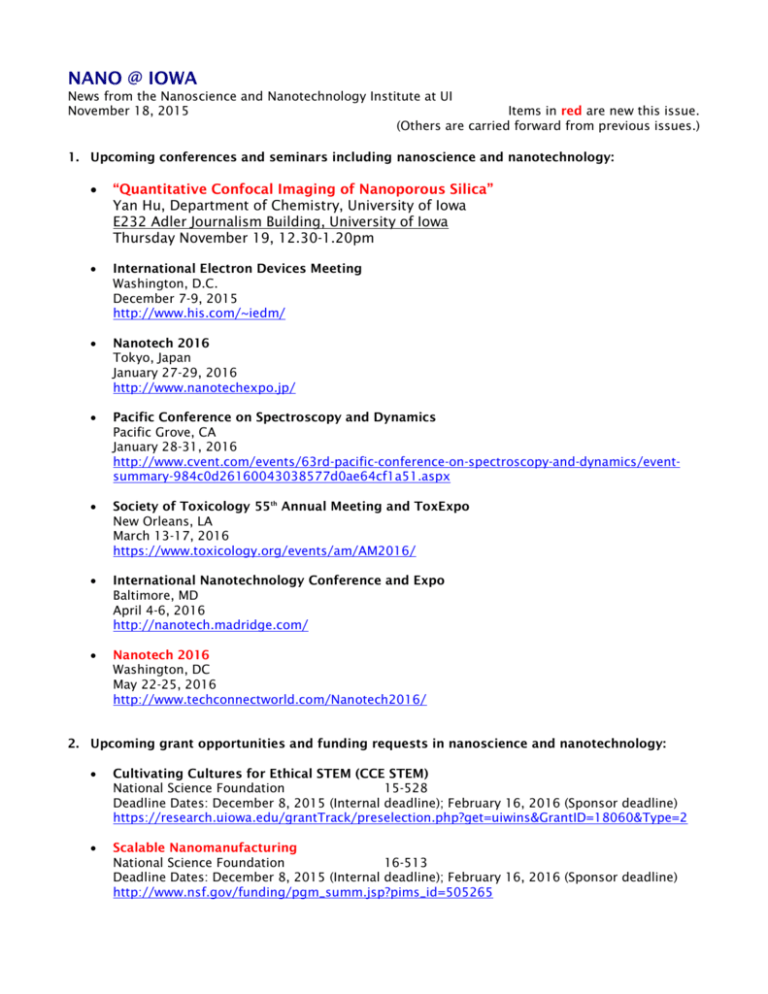
NANO @ IOWA News from the Nanoscience and Nanotechnology Institute at UI November 18, 2015 Items in red are new this issue. (Others are carried forward from previous issues.) 1. Upcoming conferences and seminars including nanoscience and nanotechnology: “Quantitative Confocal Imaging of Nanoporous Silica” Yan Hu, Department of Chemistry, University of Iowa E232 Adler Journalism Building, University of Iowa Thursday November 19, 12.30-1.20pm International Electron Devices Meeting Washington, D.C. December 7-9, 2015 http://www.his.com/~iedm/ Nanotech 2016 Tokyo, Japan January 27-29, 2016 http://www.nanotechexpo.jp/ Pacific Conference on Spectroscopy and Dynamics Pacific Grove, CA January 28-31, 2016 http://www.cvent.com/events/63rd-pacific-conference-on-spectroscopy-and-dynamics/eventsummary-984c0d26160043038577d0ae64cf1a51.aspx Society of Toxicology 55th Annual Meeting and ToxExpo New Orleans, LA March 13-17, 2016 https://www.toxicology.org/events/am/AM2016/ International Nanotechnology Conference and Expo Baltimore, MD April 4-6, 2016 http://nanotech.madridge.com/ Nanotech 2016 Washington, DC May 22-25, 2016 http://www.techconnectworld.com/Nanotech2016/ 2. Upcoming grant opportunities and funding requests in nanoscience and nanotechnology: Cultivating Cultures for Ethical STEM (CCE STEM) National Science Foundation 15-528 Deadline Dates: December 8, 2015 (Internal deadline); February 16, 2016 (Sponsor deadline) https://research.uiowa.edu/grantTrack/preselection.php?get=uiwins&GrantID=18060&Type=2 Scalable Nanomanufacturing National Science Foundation 16-513 Deadline Dates: December 8, 2015 (Internal deadline); February 16, 2016 (Sponsor deadline) http://www.nsf.gov/funding/pgm_summ.jsp?pims_id=505265 OVPRED Internal Funding Initiatives (IFI) University of Iowa Deadline dates: December 15, 2015 and March 22, 2016 http://research.uiowa.edu/researchers/find-funding/internal-funding-initiatives-ifi CHEEC seed grant research proposals University of Iowa Center for Health Effects of Environmental Contamination Deadline date: January 4, 2016 http://research.uiowa.edu/impact/news/cheec-seed-grant-research-proposals-are-due-january-4 Designing Materials to Revolutionize and Engineer our Future (DMREF) National Science Foundation 15-608 Deadline dates: January 4 – 19, 2016 http://www.nsf.gov/pubs/2015/nsf15608/nsf15608.htm?WT.mc_id=USNSF_25&WT.mc_ev=clic k 2015 Broad Agency Announcement Engineer Research and Development Center Department of Defense FOA Number: W912HZ-15-BAA-01 Deadline Date: January 31, 2016 http://nano.gov/node/1373 Materials Engineering and Processing National Science Foundation PD 13-8092 Deadline Dates: February 1 – 16, 2016 http://www.nsf.gov/funding/pgm_summ.jsp?pims_id=504950 Nanomanufacturing National Science Foundation PD 16-1788 Deadline Dates: February 1 – 16, 2016 http://www.nsf.gov/funding/pgm_summ.jsp?pims_id=13347&org=NSF Innovative Research in Cancer Nanotechnology National Institutes of Health PAR-14-285 Deadline Dates: April 14, 2016 and October 13, 2016 http://grants.nih.gov/grants/guide/pa-files/PAR-14-285.html NIST Measurement Science Research: Material Measurement; Physical Measurement; Engineering; Fire Research; Information Technology; Communications Technology; Neutron Research; Nanoscale Science National Institute of Standards and Technology 2015-NIST-MSE-01 Deadline Date: June 1, 2016 http://www.grants.gov/web/grants/view-opportunity.html?oppId=277027 FY2016 Innovations at the Nexus of Food, Energy, Water Systems (INFEWS) National Science Foundation 15-108 Deadline Date: September 30, 2016 http://www.nsf.gov/pubs/2015/nsf15108/nsf15108.jsp#ref1 Army Research Laboratory BAA for Basic and Applied Scientific Research Department of Defense FOA Number: W911NF-12-R-0011 Deadline Date: March 31, 2017 http://www.arl.army.mil/www/default.cfm?page=8 Image-guided Drug Delivery in Cancer National Institutes for Health (NIH) FOA Number: PA-09-253 Deadline Dates: January 25, May 25, and September 25, annually http://grants.nih.gov/grants/guide/pa-files/PA-09-253.html Exploratory/Developmental Bioengineering Research Grants National Institutes for Health (NIH) FOA Number: PA-12-284 Deadline Dates: January 25, May 25, and September 25, annually http://grants.nih.gov/grants/guide/pa-files/PA-12-284.html Development of Multifunctional Drug and Gene Delivery Systems National Institutes for Health (NIH) FOA Number: PA-10-048 Deadline Dates: February 5, June 5, and October 5, annually http://grants.nih.gov/grants/guide/pa-files/PAR-10-048.html Nanoscience and Nanotechnology in Biology and Medicine National Institutes of Health (NIH) FOA Number: PA-11-148 Deadline Dates: February 5, June 5, October 5, annually http://grants.nih.gov/grants/guide/pa-files/PA-11-148.html Bioengineering Nanotechnology Initiative National Institutes of Health (NIH) FOA Number: PA-10-149 Deadline Dates: April 5, August 5, December 5, annually http://www.grants.gov/web/grants/view-opportunity.html?oppId=53500 Cancer Diagnostic and Therapeautic Agents Enabled by Nanotechnology National Institutes of Health (NIH) FOA Number: PAR-10-286 Deadline Dates: April 5, August 5, December 5, annually http://grants.nih.gov/grants/guide/pa-files/PAR-10-286.html 3. Recent news and updates from NNI: David Cwiertny named one of the directors of UI Public Policy Center Associate Professor David Cwiertny has been named the new director of the Environmental Policy Research Program of the UI Public Policy Center. Cwiertny is an executive committee member of the Nanoscience and Nanotechnology Institute, an associate professor in civil and environmental engineering and a core faculty member in the campus wide Water Sustainability Initiative. His research program broadly focuses on pollutant fate in natural and engineered systems, with particular expertise related to emerging pollutant transformation pathways and the development of nanomaterial-based treatment technologies that promote water sustainability. NNI Announce Keynote Speaker for Winter 2016 Symposium The Nanoscience & Nanotechnology Institute announce Professor Karen Wooley, W. T. DohertyWelch Professor Chair and Distinguished Professor of Chemistry at Texas A&M University as this year's symposium keynote speaker! Professor Wooley has served as the director of a Program of Excellence in Nanotechnology, which is financed by the National Heart, Lung and Blood Institute, was the recipient of the 2014 Centenary Prize of Royal Society of Chemistry, and serves as an Associate Editor for the Journal of the American Chemical Society. In 2015, Professor Wooley was recognized by and named as a Fellow of the American Academy of Arts and Sciences for her expertise in the novel development of degradable polymers. Her group focuses on both fundamental and applied studies of these materials for the diagnosis and treatment of disease, use as non-toxic anti-biofouling coatings, and applications such as ultrahigh resolution photoresists for microelectronics patterning. The NNI Winter 2016 Symposium will take place on Friday February 12, 2016. Please check the symposium event page for upcoming further details: http://nanotech.uiowa.edu/events/nanoscience-and-nanotechnologywinter-symposium-2016 4. Highlights of some new interesting nanoscience and nanotechnology research and articles: A new way to look at metal organic frameworks An international collaboration of scientists led by Omar Yaghi, a renowned chemist with the Lawrence Berkeley National Laboratory (Berkeley Lab), has developed a technique they dubbed "gas adsorption crystallography" that provides a new way to study the process by which metalorganic frameworks (MOFs) - 3D crystals with extraordinarily large internal surface areas - are able to store immense volumes of gases such a carbon dioxide, hydrogen and methane. This new look at MOFs led to a discovery that holds promise for the improved design of MOFs tailored specifically for carbon capture, or for the use of hydrogen and natural gas (methane) fuels. "Up to this point we have been shooting in the dark in our designing of MOFs without really understanding the fundamental reasons for why one MOF is better than another," says Yaghi. "Our new study expands our view and thinking about MOFs by introducing gas-gas interactions and their organization into superlattices that are a major factor in achieving high storage capacity for gases." http://www.nanowerk.com/nanotechnology-news/newsid=41801.php Onion-like layers help this efficient new nanoparticle glow A new, onion-like nanoparticle could open new frontiers in biomaging, solar energy harvesting and light-based security techniques. The particle's innovation lies in its layers: a coating of organic dye, a neodymium-containing shell, and a core that incorporates ytterbium and thulium. Together, these strata convert invisible near-infrared light to higher energy blue and UV light with record-high efficiency, a trick that could improve the performance of technologies ranging from deep-tissue imaging and light-induced therapy to security inks used for printing money. When it comes to bioimaging, near-infrared light could be used to activate the light-emitting nanoparticles deep inside the body, providing high-contrast images of areas of interest. In the realm of security, nanoparticle-infused inks could be incorporated into currency designs; such ink would be invisible to the naked eye, but glow blue when hit by a low-energy laser pulse—a trait very difficult for counterfeiters to reproduce. "It opens up multiple possibilities for the future," says Tymish Ohulchanskyy, deputy director of photomedicine and research associate professor at the Institute for Lasers, Photonics, and Biophotonics (ILPB) at the University at Buffalo. "By creating special layers that help transfer energy efficiently from the surface of the particle to the core, which emits blue and UV light, our design helps overcome some of the long-standing obstacles that previous technologies faced," says Guanying Chen, professor of chemistry at Harbin Institute of Technology and ILPB research associate professor. http://phys.org/news/2015-11-onion-like-layers-efficient-nanoparticle.html Engineers make material gains to improve desalination process In a study published in Nature Communications, the Illinois team modelled various thin-film membranes and found that MoS2 showed the greatest efficiency, filtering through up to 70 per cent more water than graphene membranes. “Even though we have a lot of water on this planet, there is very little that is drinkable,” said study leader Narayana Aluru, a U. of I. professor of mechanical science and engineering. “If we could find a low-cost, efficient way to purify sea water, we would be making good strides in solving the water crisis. “Finding materials for efficient desalination has been a big issue, and I think this work lays the foundation for nextgeneration materials. These materials are efficient in terms of energy usage and fouling, which are issues that have plagued desalination technology for a long time,” Aluru said in a statement. Most available desalination technologies rely on reverse osmosis, a process that yields relatively small amounts of fresh water. “Reverse osmosis is a very expensive process,” Aluru said. “It’s very energy intensive. A lot of power is required to do this process, and it’s not very efficient. In addition, the membranes fail because of clogging. So we’d like to make it cheaper and make the membranes more efficient so they don’t fail as often. We also don’t want to have to use a lot of pressure to get a high flow rate of water.” http://www.theengineer.co.uk/energy/news/engineers-make-material-gains-to-improvedesalination-process/1021398.article Nanotech-based sensor developed to measure microRNAs in blood, speed cancer detection In a study published in the Nov. issue of ACS Nano, a peer-reviewed journal of the American Chemical Society focusing on nanoscience and nanotechnology research, the IUPUI researchers describe their design of the novel, low-cost, nanotechnology-enabled reusable sensor. They also report on the promising results of tests of the sensor's ability to identify pancreatic cancer or indicate the existence of a benign condition by quantifying changes in levels of microRNA signatures linked to pancreatic cancer. MicroRNAs are small molecules of RNA that regulate how larger RNA molecules lead to protein expression. As such, microRNAs are very important in biology and disease states. "We used the fundamental concepts of nanotechnology to design the sensor to detect and quantify biomolecules at very low concentrations," said Rajesh Sardar, Ph.D., who developed the sensor. "We have designed an ultrasensitive technique so that we can see minute changes in microRNA concentrations in a patient's blood and confirm the presence of pancreatic cancer." Sardar is an assistant professor of chemistry and chemical biology in the School of Science at IUPUI and leads an interdisciplinary research program focusing on the intersection of analytical chemistry and the nanoscience of metallic nanoparticles. http://www.sciencedaily.com/releases/2015/11/151117112527.htm About NANO @ IOWA NANO @ IOWA is a biweekly electronic newsletter to inform faculty, staff and students about important news and events in nanoscience and nanotechnology. This newsletter is provided as a service of the Nanoscience and Nanotechnology Institute at UI (NNI). To subscribe to NANO @ IOWA, please send an email to NNI@uiowa.edu with subject line: Subscribe NANO @ IOWA. In the body of the message, type: (your first name) (your last name). To unsubscribe, send an email message to: NNI@uiowa.edu with subject line: Unsubscribe NANO @ IOWA. In the body of the message, type: (your first name) (your last name). If you have news for NANO @ IOWA, please e-mail jenny-nelson@uiowa.edu or call Jenny Nelson at 319-384-3292. http://nanotech.uiowa.edu
